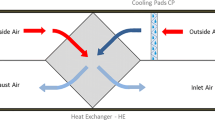Abstract
This study aimed at evaluating the use of polypropylene fabrics in weaned pig facilities (5–10 weeks of age) during the winter period to improve thermal environment and energy saving for heating. Two experiments were conducted to validate the effects of fabrics (F) compared to control (C) in three 2-week periods using natural ventilation (assay 1, 2013) and forced ventilation (assay 2, 2014). Air temperature was greater in F than in C compartments in both years, particularly during the first 2-week periods (2 °C of mean difference). Natural ventilation was not enough to maintain relative humidity levels below 70 % at the end of the postweaning period (9–10 weeks of age) in both groups (F and C), whereas forced ventilation allowed controlling daily mean relative humidity levels <60 %. About 12–26 % of the radiant heat was transmitted through the fabrics cover, depending on the wavelength. There were no differences on growth performance of piglets in the two compartments in both years. The use of polypropylene fabrics was associated with a significant electric energy saving for heating during the first (data available only in 2014) and second 2-week period in both years. In conclusion, polypropylene fabrics may be an interesting tool to provide optimal environmental conditions for weaned piglets in winter, especially during the two first weeks after weaning. Their transmittance properties allow trapping infrared emission produced by the piglets and heating, avoiding heat losses through the roof, and therefore saving heating energy.



Similar content being viewed by others
References
Balaras CA, Argiriou AA (2002) Infrared thermography for building diagnostics. Energy Build 34:171–183. doi:10.1016/S0378-7788(01)00105-0
Bresk B, Stolpe J (1988) Effect of medium or high humidities of live weight gain exposed to different ambient temperatures. Monatsh Veterinarmed 43:191–193
Brown-Brandl TM, Nienaber JA, Xin H, Gates RS (2004) A literature review of swine heat production. T ASAE 47:259–270
Brumm MC, Shelton DP (1991) Two reduced nocturnal temperature regimens for early-weaned pigs. J Anim Sci 69:1379–1388
CIGR (1984) Climatization of Animal Houses. CIGR Section II. 1st Report of Working Group. Int Comm Agric Eng
CIGR (2002) Heat and Moisture Production at Animal and House Levels. CIGR Section II, 4th Report of Working Group of Climatization of Animal Houses. In: Pedersen S, Sällvik J (eds). International Commission of Agricultural Engineering
Feenstra A (1985) Effects of air temperature on weaned pigs. Pig News Info 6:295–299
Fina A, Feng J, Cuttica F (2013) In-depth radiative heat transmittance through polypropylene/nanoclay composites. Polym Degrad Stab 98:1030–1035
Forcada F, Guillén R, Babot D, Álvarez-Rodríguez J (2014) Condiciones ambientales en el interior de un cebadero porcino en el Valle del Ebro. Influencia de la orientación frente a los vientos dominantes. ITEA 110(3):236–250
Hou Y, Velthof GL, Oenema O (2015) Mitigation of ammonia, nitrous oxide and methane emissions from manure management chains: a meta-analysis and integrated assessment. Glob Change Biol 21:1293–1312. doi:10.1111/gcb.12767
Johnston LJ, Brumm MC, Moeller SJ, Pohl S, Shannon MC, Thaler RC (2013) Effects of reduced nocturnal temperature on pig performance and energy consumption in swine nursery rooms. J Anim Sci 91:3429–3435
Kurata K (1991) View factors involved in radiation exchanges in floating mulches made of non-woven fabrics. J Agric Eng Res 48:185–193
Le Dividich J, Herpin P (1994) Effects of climatic conditions on the performance, metabolism and health status of weaned piglets: a review. Livest Prod Sci 38:79–90
Le Dividich J, Vermorel M, Noblet J, Bouvier JC, Aumaitre A (1980) Effects of environmental temperature on heat production, energy retention, protein and fat gain in early weaned piglets. Br J Nutr 44:313–323
McCracken KJ, Caldwell BJ (1980) Studies on diurnal variations of heat production and the effective lower critical temperature of early-weaned pigs under commercial conditions of feeding and management. Br J Nutr 43:321–328
Morrison SR, Heitman JH, Bond TE (1969) Effect of humidity on swine at temperatures above optimum. Int J Biometeorol 13:135–139
O’Connor EA, Parker MO, McLeman MA, Demmers TG, Lowe JC, Cui L, Davey EL, Owen RC, Wathes CM, Abeyesinghe SM (2010) The impact of chronic environmental stressors on growing pigs, Sus scrofa (Part 1): stress physiology, production and play behaviour. Animal 4:1899–1909
Patton AJ, Trappe JM, Richardson MD (2010) Cover technology influences warm-season grass establishment from seed. Hort Tech 20(1):153–159
Portejoie S, Martínez J, Guiziou F, Coste CM (2003) Effect of covering pig slurry stores on the ammonia emission processes. Biores Technol 87:199–207
Sarubbi J, Rossi LA, de Moura DJ, De Oliveira RA, David E (2010) Electrical energy use in different heating systems for weaned piglets. Eng Agrícola 30:1003–1011
Shelton DP, Brumm MC (1983) Hovers in flat-deck swine nursery pens. ASAE Paper n° 83–4010. ASAE, St. Joseph
Shelton DP, Brumm MC (1984) Response of nursery pigs to reduced nocturnal temperatures. ASAE Paper n° 84–4021. ASAE, St. Joseph
Siegel R, Howell J (2002) Thermal radiation heat transfer. Taylor & Francis, USA
Svennerstedt B (1999) Drainage properties and ammonia emissions in slatted floor systems for animal buildings. J Agric Eng Res 72:19–25
Whittemore CT, Aumaitre A, Williams IH (1978) Growth of body components in young weaned pigs. J Agric Sci 91:681–692
Acknowledgments
The authors wish to thank the staff of the Centre d’Estudis Porcins (CEP Diputació de Lleida, Spain) for their technical assistance.
Conflict of interest
The authors declare that they have no conflict of interest.
Ethical approval
All applicable international, national, and/or institutional guidelines for the care and use of animals were followed.
Author information
Authors and Affiliations
Corresponding author
Rights and permissions
About this article
Cite this article
Dolz, N., Babot, D., Álvarez-Rodríguez, J. et al. Improving the environment for weaned piglets using polypropylene fabrics above the animals in cold periods. Int J Biometeorol 59, 1839–1847 (2015). https://doi.org/10.1007/s00484-015-0991-0
Received:
Revised:
Accepted:
Published:
Issue Date:
DOI: https://doi.org/10.1007/s00484-015-0991-0




